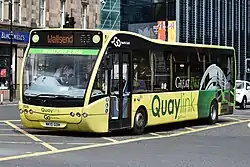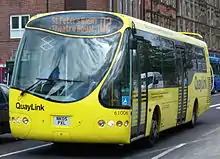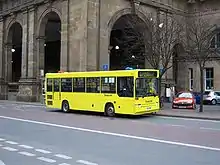QuayLink
QuayLink is a bus service in Tyne and Wear, England, connecting Newcastle city centre and Gateshead with the Quayside area. Conceived as a high-quality environmentally friendly operation and funded by Nexus, it was launched in 2005. Following budget cuts in 2015, the service is now operated by Go North East on a commercial basis, having been extended further into the suburbs.
 | |
| Parent | Tyne and Wear PTE (2005–2015) |
|---|---|
| Commenced operation | 22 July 2005 (15 years ago) |
| Locale | Tyne and Wear |
| Service area | |
| Service type | Bus service |
| Routes | 3 |
| Fleet |
|
| Operator |
|
| Website | Go North East |
Introduction

QuayLink was conceived as a frequent, high quality bus service, for the newly developed and expanding Quayside area. Despite being located a short distance from the town centres of Newcastle and Gateshead, the area was poorly served by public transport.
In June 2002, Newcastle City Council and Gateshead Council, along with Nexus, invited tenders for operation of a proposed Tyne Quayside Link, as well as the manufacture of eight alternatively-fuelled buses for a Quayside Transit System. The proposed project, scheduled for launch in 2004, would cost £5 million – with £3 million coming from the local transport plan, £1 million from regeneration funds for Gateshead, and £1 million from the Quayside developers. As well as new buses, the project involved the construction of a bus lane, and improvements to some bus stops, making them fully accessible.[1][2]
QuayLink brand was launched in July 2005, using a fleet of ten Designline Olymbus turbine-electric hybrid vehicles – a project costing £8 million.[3] Prior to the launch, all ten vehicles were pictured, along with local dignitaries and partner representatives, at an opening ceremony held on the Quayside.[4]
Service and operations
Stagecoach North East (2005–2010)


Fleet and operations
Stagecoach North East won the contract to operate the service, with a fleet of ten Designline Olymbus turbine-electric hybrid vehicles, built in New Zealand. A prototype arrived in October 2004, subsequently touring across the country as a demonstration vehicle, until April 2005. Delivery of the remaining nine vehicles to the depot at Walkergate followed, after the completion of upgrades to the depot, necessary to receiving the new vehicles.[5]
The vehicles were substantially modified for operation in England, notably using a leaf door design, over the plug design. Vehicles were dual-doored, with the middle door used only for wheelchair access.[5] Initially, the vehicles were turbine-electric hybrids, in which the wheels were driven only by electric motors, powered by on-board battery packs. The batteries were charged overnight, and then re-charged while the bus was in operation by a liquid-fuelled turbine-generator and through regenerative braking. Even with the turbine running, the buses were credited with a markedly quiet ride, when compared to regular diesel-powered vehicles.
By the end of 2008, the turbines were unable to keep the batteries charged for the whole day, leading to some instances of service cancellations, and vehicles being temporarily withdrawn from service. Stagecoach North East announced its intention to replace the turbine and generators with a diesel engine as an alternative charging system, with the modification planned to be completed on one vehicle on a trial basis, and evaluated in early 2009. The anticipated cost of modifying the whole fleet was estimated to cost around £200,000.[6]
Following contract changes in July 2010, the vehicles were withdrawn from service – aged just over five years old. They were later sold for scrap, with plans by Nexus to use them on other routes not coming to fruition.[7]
Service, routes and frequency
A partial service launched on 22 July 2005, with QuayLink operating as a free shuttle service, coinciding with the 2005 Tall Ships Race. Full service commenced on 29 July 2005, with two routes, operating at a 10 minute frequency:[8][9]
- Q1 connected Newcastle Central station with the Gateshead Quayside and Gateshead Interchange. Crossing the River Tyne, using the Swing Bridge, the route served the Baltic Centre for Contemporary Art and The Sage Gateshead.
- Q2 connected Haymarket bus station with the Newcastle Quayside and Ouseburn.
Both routes combined on a short section between Grey Street and the Quayside, with stops at Theatre Royal, Grey Street and Guildhall. Initially, passenger numbers were low, with QuayLink carrying around 11,000 passengers each week. Ridership later increased, with one million journeys having been made by May 2007.[10][11] In September 2007, following the re-development of the Ouseburn Valley, Q2 was extended to Hoults Yard and St. Peter's Basin.
Go North East (2010–present)
%252C_7_November_2013.jpg.webp)
Fleet and operations
Prior to the re-awarding of the QuayLink contract by Nexus, in July 2010, it was decided that the service should receive new vehicles, owing to the overall poor reliability of the existing fleet.[12]
Go North East was awarded the five-year contract to operate QuayLink, with operations transferred to the company's Saltmeadows Road depot in Gateshead, in July 2010. The fleet consisted of nine Euro 5 diesel-powered Optare Versa vehicles, which entered service in August 2010. Operations were later transferred within the company, following the opening of the new Riverside depot in Gateshead, in February 2015. The vehicles provided increased seating capacity, when compared to the former fleet, as well as on-board next stop audio-visual information displays.[13][14]
In 2017, the QuayLink fleet was fitted with free on-board WiFi. As of March 2020, vehicles are in the process of being upgraded from their current Euro 5, to Euro 6 standard, ahead of the introduction of Newcastle's Clean Air Zone in 2021.[15][16]
Service, routes and frequency
Under Go North East, the service operated to the same routes and frequency as previously operated by Stagecoach North East. At the end of 2014, it was announced that Newcastle City Council and Gateshead Council would no longer fund QuayLink beyond the end of the contract, due to finish in July 2015. Go North East opted to continue to operate the service on a commercial basis, with minimal funding from Nexus, which itself would also end three years later.[17][18]
In late July 2015, Go North East relaunched QuayLink, with a new look and significant route changes:[19]
Route Q1 & Q2 |
|---|
- Q1 was merged with the existing Orbit branded 51 and 52 circular services, and renumbered Q1 and Q2. These changes extended the reach of the QuayLink network to East Gateshead, with the circular route connecting Felling, Heworth, Leam Lane Estate, Wrekenton and Low Fell.
Route Q3 | ||||||||||||||||||||||||||||||||||||||||||||||||||||||||||||||||||||||||||||||||||||||||||||||||||||||||||||||||||||||||||||||||||||||||||||||||||||||||||||||||||||||||
|---|---|---|---|---|---|---|---|---|---|---|---|---|---|---|---|---|---|---|---|---|---|---|---|---|---|---|---|---|---|---|---|---|---|---|---|---|---|---|---|---|---|---|---|---|---|---|---|---|---|---|---|---|---|---|---|---|---|---|---|---|---|---|---|---|---|---|---|---|---|---|---|---|---|---|---|---|---|---|---|---|---|---|---|---|---|---|---|---|---|---|---|---|---|---|---|---|---|---|---|---|---|---|---|---|---|---|---|---|---|---|---|---|---|---|---|---|---|---|---|---|---|---|---|---|---|---|---|---|---|---|---|---|---|---|---|---|---|---|---|---|---|---|---|---|---|---|---|---|---|---|---|---|---|---|---|---|---|---|---|---|---|---|---|---|---|---|---|---|
| ||||||||||||||||||||||||||||||||||||||||||||||||||||||||||||||||||||||||||||||||||||||||||||||||||||||||||||||||||||||||||||||||||||||||||||||||||||||||||||||||||||||||
- Q2 was merged with the existing Great Park & Ride branded X40 route, and renumbered Q3. This extended the network north, beyond Haymarket, to Gosforth and Great Park. The route was later extended to Walker and Wallsend, in July 2016.[20][21]
The relaunched services continued to use the existing QuayLink fleet, in addition to additional Optare Versa vehicles formerly used on the Orbit services. A new yellow and purple livery was introduced for the Q1 and Q2, with a yellow and green livery for the Q3.However it is now called QuayCity[22] As of March 2020, 23 Versas were painted in Quaylink livery.[23]
References
- "Tyneside's QuayLink scheme". CommuniGate. Archived from the original on 24 July 2008. Retrieved 28 March 2020.
- "What is Quaylink?". Quayside Transit. Archived from the original on 20 August 2008. Retrieved 28 March 2020.
- "Backing for electric bus service". BBC News. 13 March 2006. Retrieved 28 March 2020.
- "Tyneside's QuayLink scheme". CommuniGate. Archived from the original on 24 July 2008. Retrieved 28 March 2020.
- "Getting the buses into service". CommuniGate. Archived from the original on 12 June 2011. Retrieved 28 March 2020.
- "Quaylink bus service faces £200,000 repairs". ChronicleLive. 4 March 2016. Archived from the original on 4 March 2016. Retrieved 28 March 2020.
- "Designlines to be Scrapped?". Focus Transport. 17 March 2013. Retrieved 28 March 2020.
- "FREE QuayLink buses during Tall Ships' Races". Stagecoach. 13 July 2005. Archived from the original on 6 November 2007. Retrieved 28 March 2020.
- Tyneside's hi-tech quay to the future On Stage issue 59 July 2005 page 3
- "Stagecoach QuayLink's extension proposal". Bus and Coach Professional. 14 March 2006. Archived from the original on 7 November 2017. Retrieved 28 March 2020.
- "Yellow buses set for 1m". ChronicleLive. 10 May 2007. Retrieved 28 March 2020.
- "Plug pulled on Newcastle quayside electric bus". ChronicleLive. 27 June 2010. Retrieved 28 March 2020.
- "New diesel Quaylink buses still eco-friendly". ChronicleLive. 10 August 2010. Retrieved 28 March 2020.
- "Brand new QuayLink fleet takes to the road". Nexus. 9 August 2010. Archived from the original on 1 November 2017. Retrieved 28 March 2020.
- "Newcastle City Council backs clean air toll plan". BBC News. 9 January 2020. Retrieved 28 March 2020.
- Ames, Chris (14 January 2020). "Newcastle given room to breathe". Transport Network. Retrieved 28 March 2020.
- "Quaylink bus service to be saved after councils funding withdrawn". ITV News. 18 December 2014. Retrieved 28 March 2020.
- Quaylink fuels row over quality contracts Bus & Coach Professional 19 December 2014
- "The new look Quaylink bus service". Get into Newcastle. July 2015. Retrieved 28 March 2020.
- "Quaylink extends in to East Newcastle". Go North East. 21 July 2016. Retrieved 28 March 2020.
- "Service changes in North Tyneside from 24 & 31 July". Go North East. 28 June 2016. Retrieved 28 March 2020.
- Holley, Mel (4 May 2016). "Improved Quaylink bucks trend". routeone. Archived from the original on 1 November 2017. Retrieved 28 March 2020.
- Fleetcard Go North East 15 March 2020
External links
| Wikimedia Commons has media related to QuayLink. |
